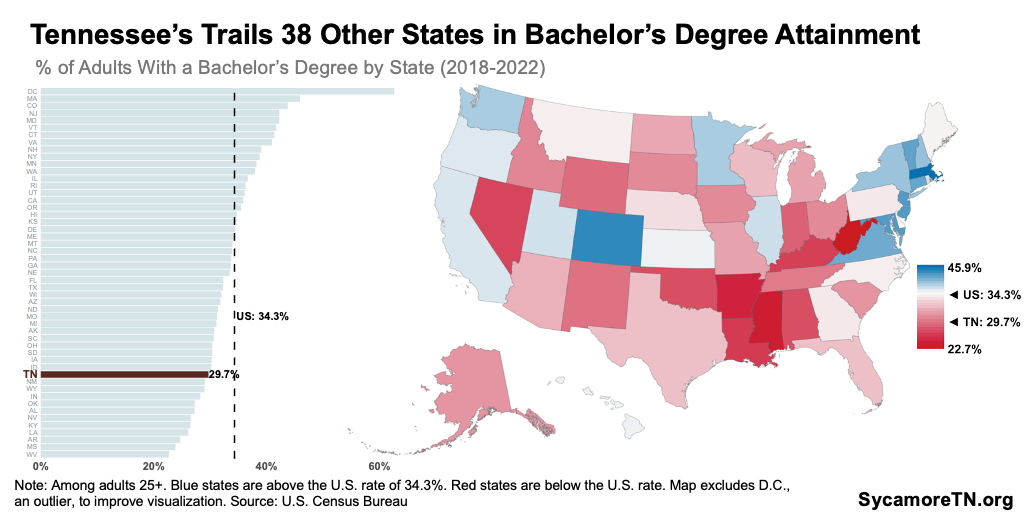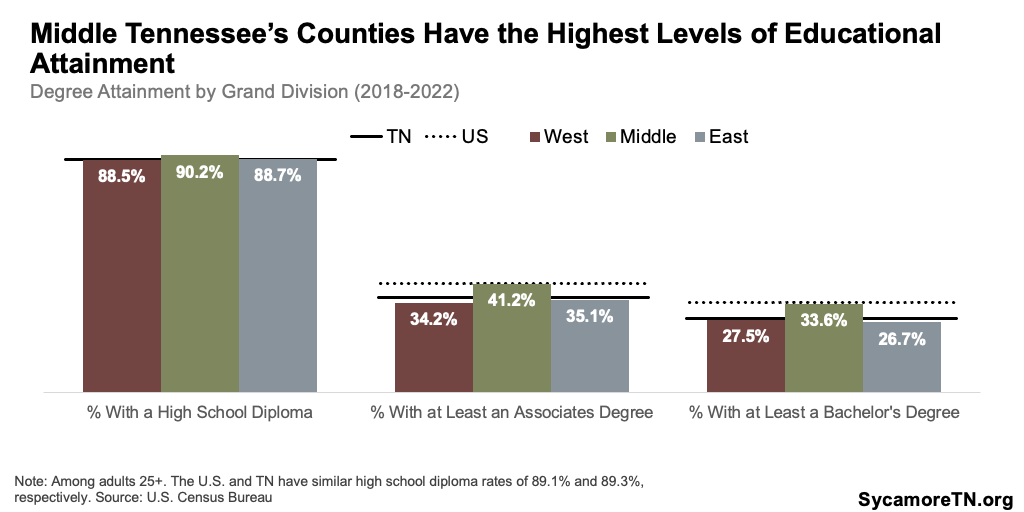Key Takeaways
-
- Tennessee’s 95 counties continued to experience large differences in income levels, poverty rates, educational attainment, and health insurance status in 2018-2022.
- On average, Middle Tennesseans had the highest education and income levels and the lowest poverty and uninsured rates.
- Relative to Tennessee’s rural counties, the state’s urban counties had higher rates of educational attainment, higher income levels, less poverty, and lower uninsured rates.
- The poverty rate in most Tennessee counties exceeded the U.S. rate, and the child poverty rate in many counties was even higher than their overall poverty rate.
- Tennessee ranked behind 38 states and the District of Columbia in the share of adults (25+) with at least a bachelor’s degree and in the share of individuals with health insurance.
The latest U.S. Census Bureau data for Tennessee’s 95 counties show large differences in income, poverty, health insurance coverage, and educational attainment. Middle Tennesseans generally had the lowest poverty rates, highest median household incomes, and highest levels of education compared to West and East Tennesseans. Meanwhile, Tennesseans living in rural counties were more likely to be uninsured than those in urban counties.
Note: The numbers analyzed here are based on five years of data (2018-2022) rather than single-year estimates. (1) The Census Bureau uses these to produce more reliable estimates for less populated counties. The Census recommends that five-year estimates not be compared to previous ones when they include overlapping years. See the final section of this policy brief for more details.
Urban and rural counties are defined using the following definitions from the 2020 Census (Figure 1):
- Urban Counties — 23 counties in which 50% or more of the population lives in an area designated as urban.
- Rural Counties — 72 counties in which less than half of the population lives in urban areas. (2)
Figure 1
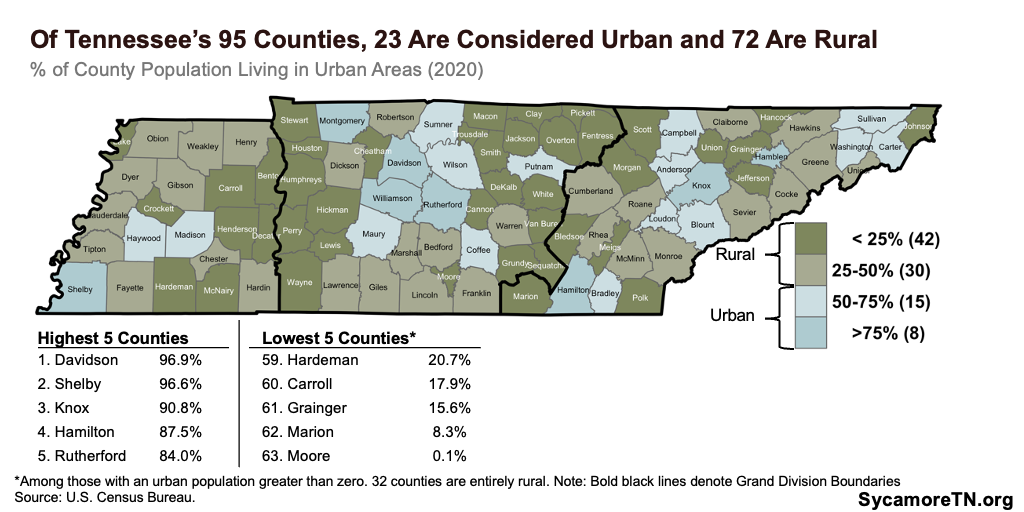
Income and Poverty
From 2018-2022, Tennessee had a lower median household income and a higher poverty rate than most of the country (Figures 2 and 4). At $64,035, the state had the 10th lowest median household income. Tennessee’s poverty rate was 14% — the 10th highest rate and nearly double the lowest rate of 7.3% in New Hampshire.
Figure 2
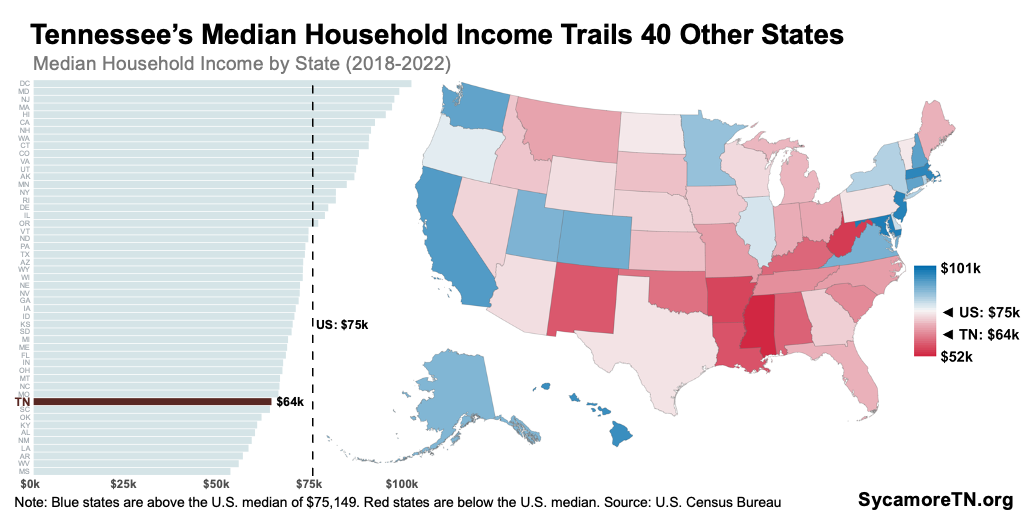
Within Tennessee, county-level income and poverty rates varied widely (Figures 3 and 5). High-income counties typically had lower poverty rates than low-income counties (Figure 6). For example, Williamson County led the state with a median household income of $125,943, almost four times the level in Hancock County, the lowest at $31,809. The poverty rate was also lowest in Williamson at 4.2%, nearly eight times lower than the level in Hancock County, the highest at 32.3%.
Figure 3
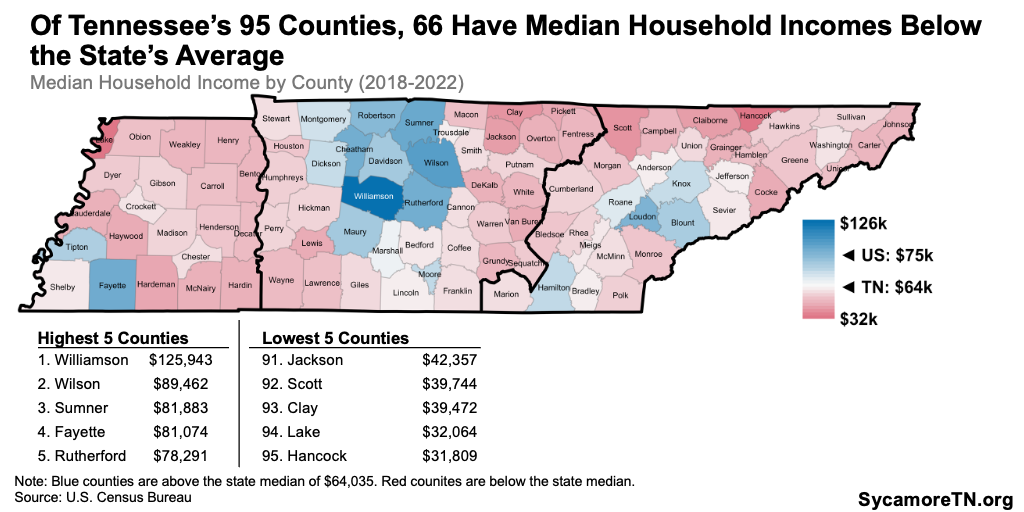
Figure 4
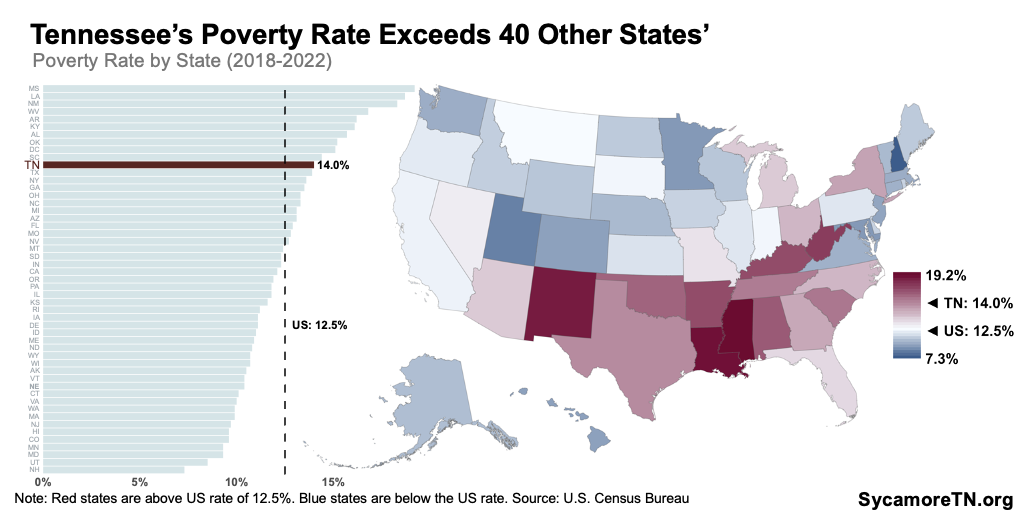
Figure 5
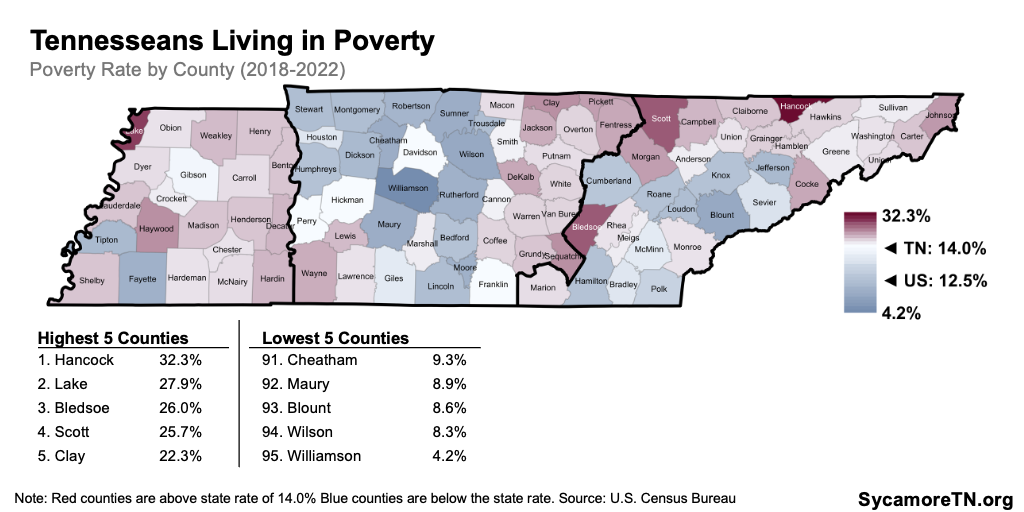
Figure 6
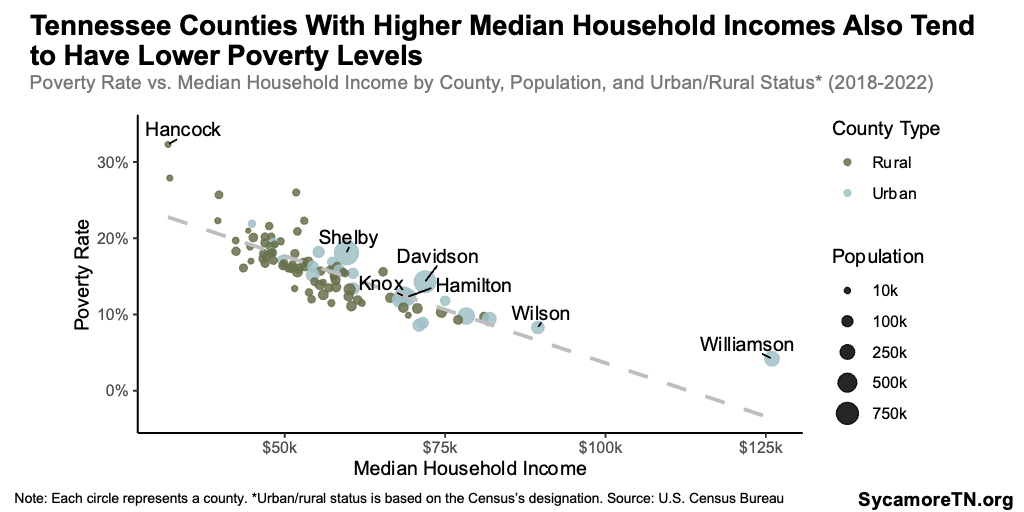
Figure 7
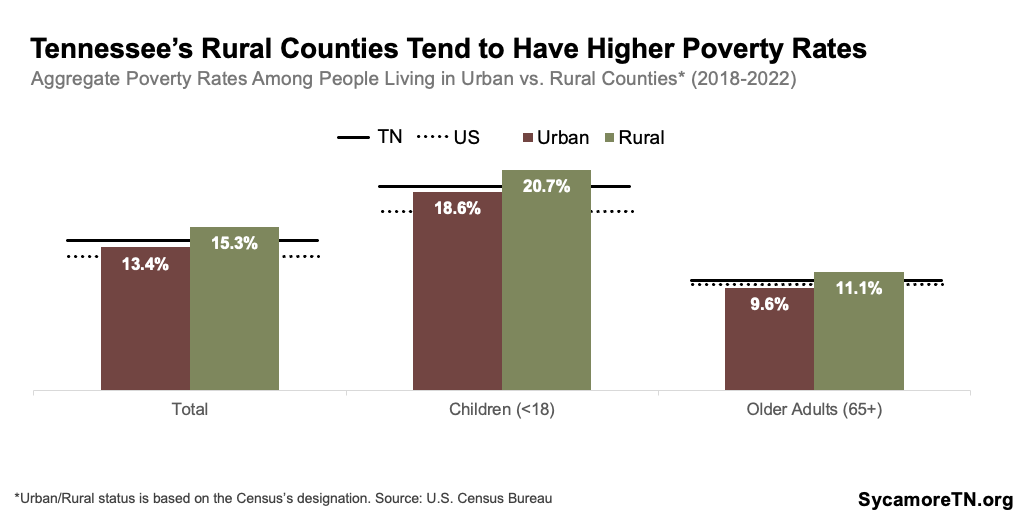
Other key findings include:
- Rural vs Urban – Tennesseans living in rural counties had higher poverty rates and lower incomes than those in urban counties (Figures 7 and 8). Though 67% of impoverished Tennesseans lived in one of the 23 urban counties, 15.3% of those in rural counties were in poverty — compared to 13.4% in urban counties. (3) The average county median household income was $53,325 in Tennessee’s 72 rural counties — compared to $66,179 in the state’s 23 urban counties. (4)
- Grand Division – Residents of Middle Tennessee counties had lower poverty rates and higher incomes than Tennesseans in the state’s other two regions (Figure 9). The poverty rate in West Tennessee (17.4%) exceeds that of East (14.1%) and Middle Tennessee (12.0%). (3) The average of counties’ median household incomes varied significantly by Grand Division: $59,780 in the 41 Middle Tennessee counties, $54,962 in the 33 East Tennessee counties, and $52,229 in the 21 West Tennessee counties. (4)
- Child Poverty – Child poverty rates were higher than overall poverty rates in 87 of Tennessee’s 95 counties (Figure 10). In Hancock County, more than four out of every nine children, or 45.7%, live in poverty. In Williamson County, the figure is much lower, with fewer than four out of every 100 children living in poverty, or 3.4% of children. (3)
- Older Adults – Poverty rates among older adults 65+ were generally lower than those for other populations but vary significantly by county (Figure 11). In Hancock County, more than one in every four older adults lived in poverty, or 25.1%. Fewer than one in 20 older adults in Williamson County did, or 4.5%.
Figure 8
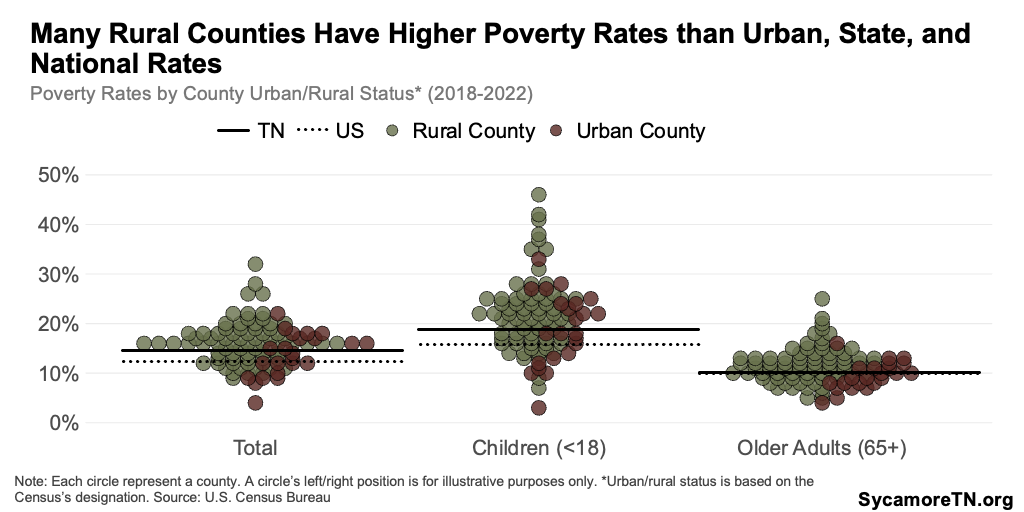
Figure 9
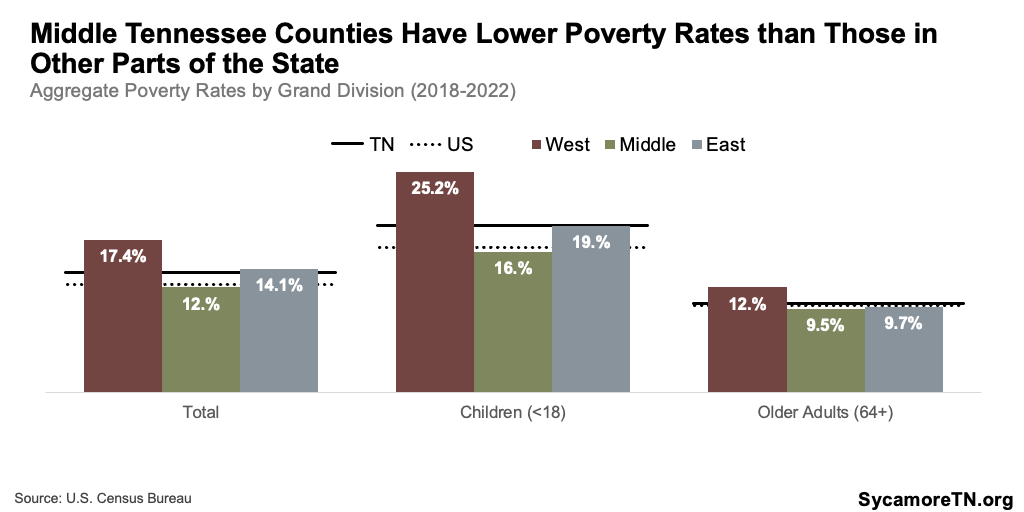
Figure 10
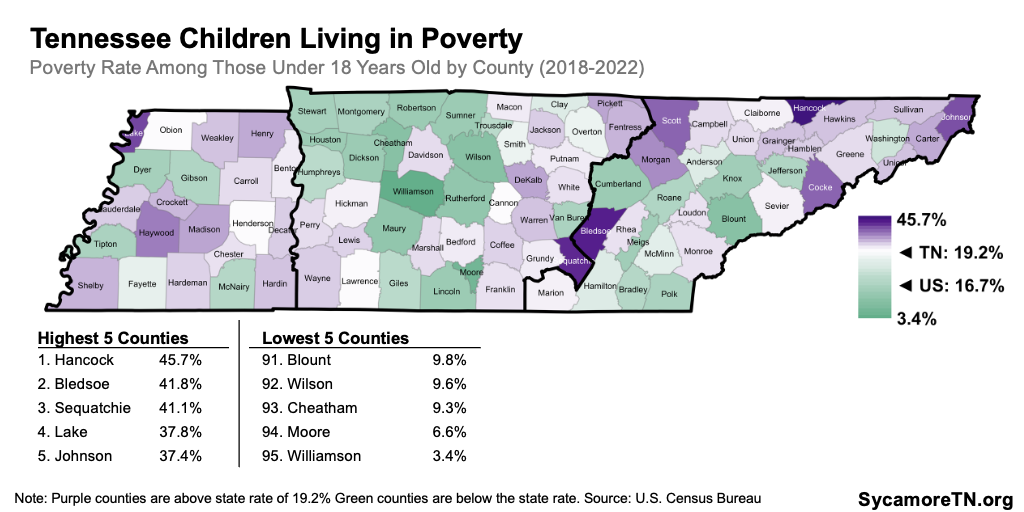
Figure 11
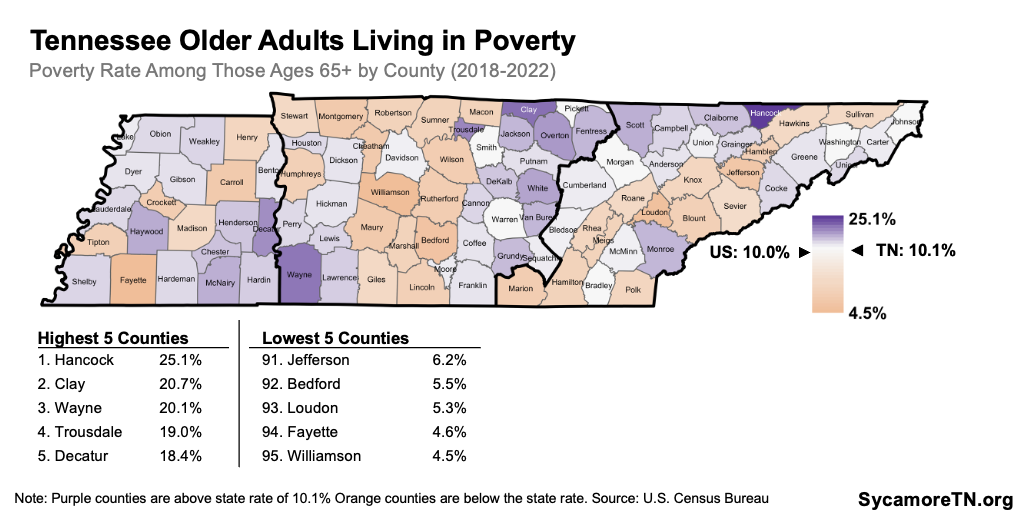
Levels of Education
From 2018-2022, Tennessee ranked behind most of the country in levels of post-secondary educational attainment (Figure 12). The share of those ages 25+ with at least a bachelor’s degree was 29.7% — behind 38 other states and D.C. The share of Tennessee adults ages 25+ with at least an associate’s degree was 27.4% — lower than 40 other states and D.C. (5)
Within Tennessee, levels of adult educational attainment varied significantly by county (Figures 13–15). For example, Williamson County led the state with 62.0% of residents aged 25+ holding at least a bachelor’s degree — over six times the Lewis County rate of 9.3%. (5)
Figure 12
Figure 13
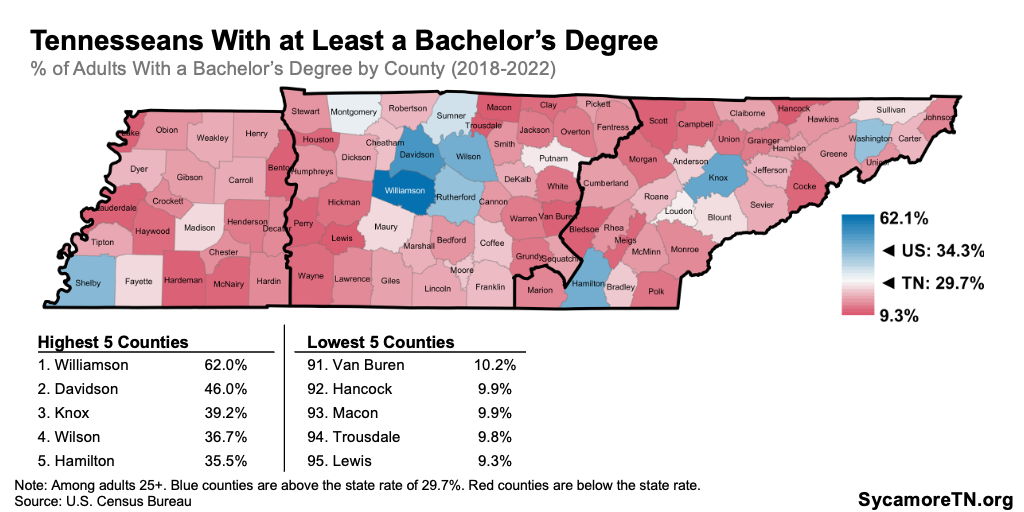
Figure 14
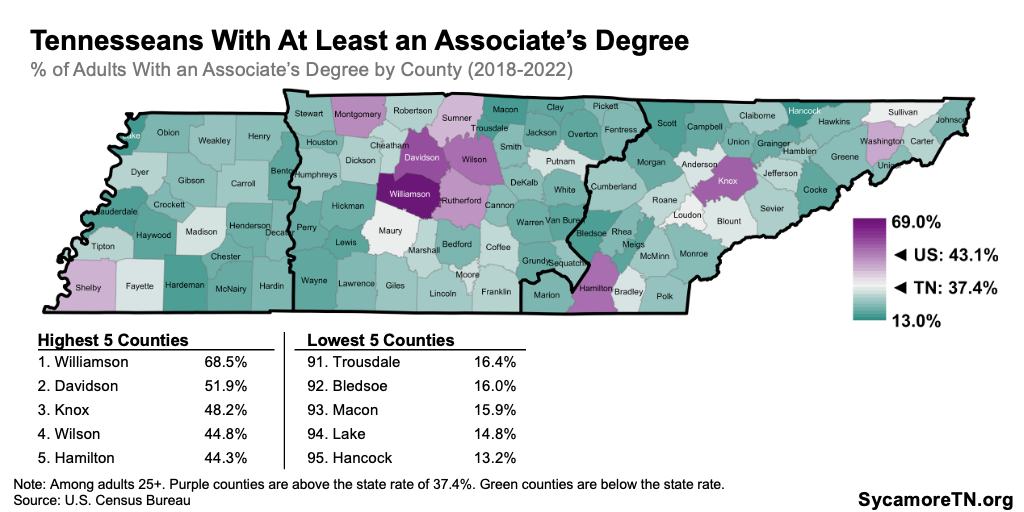
Figure 15
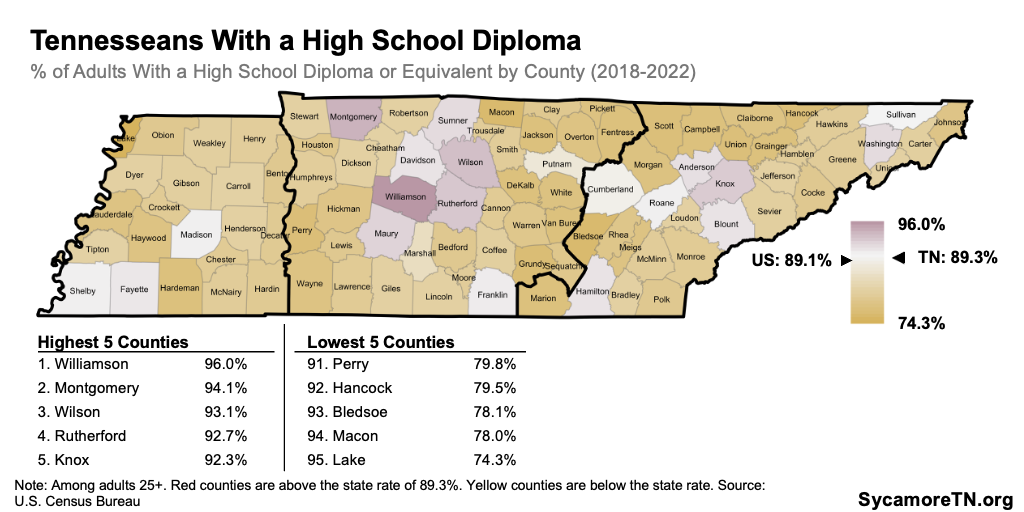
Figure 16
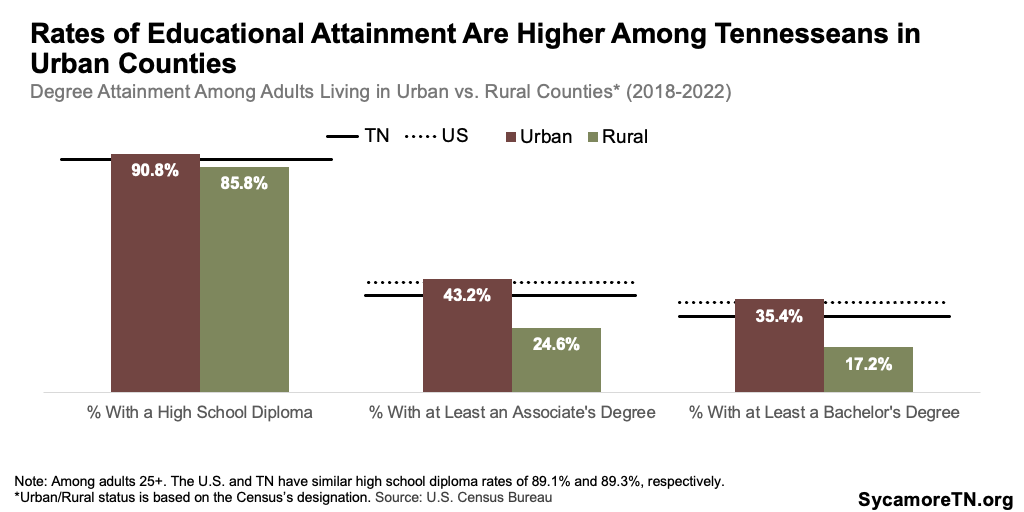
Other key findings include:
- Rural vs. Urban – Educational attainment rates were higher among adults in Tennessee’s urban counties (Figures 16 and 17). For example, 90.8% of adults in urban counties held a high school diploma, 43.2% had at least an associate’s degree and 35.4% had a bachelor’s degree. The high school, associate’s, and bachelor’s degree rates in rural areas were 85.8%, 24.6%, and 17.2%, respectively. (5)
- Grand Division – Middle Tennesseans had higher educational attainment than the other two regions in 2018-2022 (Figure 18). For example, 33.6% of adults 25+ in Middle Tennessee had at least a bachelor’s degree, compared to 27.5% in West Tennessee and 26.7% in East Tennessee. (5)
- Education and Income – Counties with higher levels of educational attainment tended to have higher household median incomes. These counties also tended to be urban (Figure 19). (5)
Figure 17
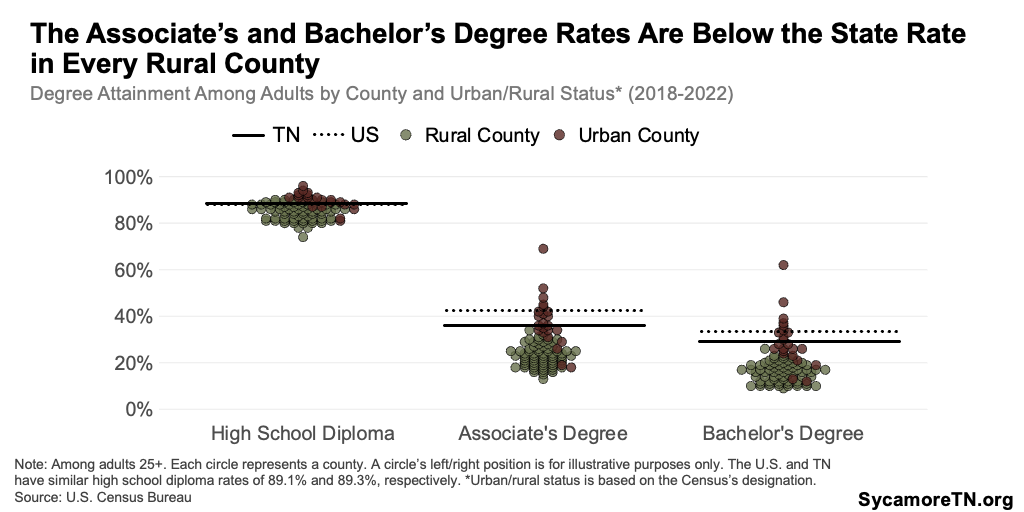
Figure 18
Figure 19
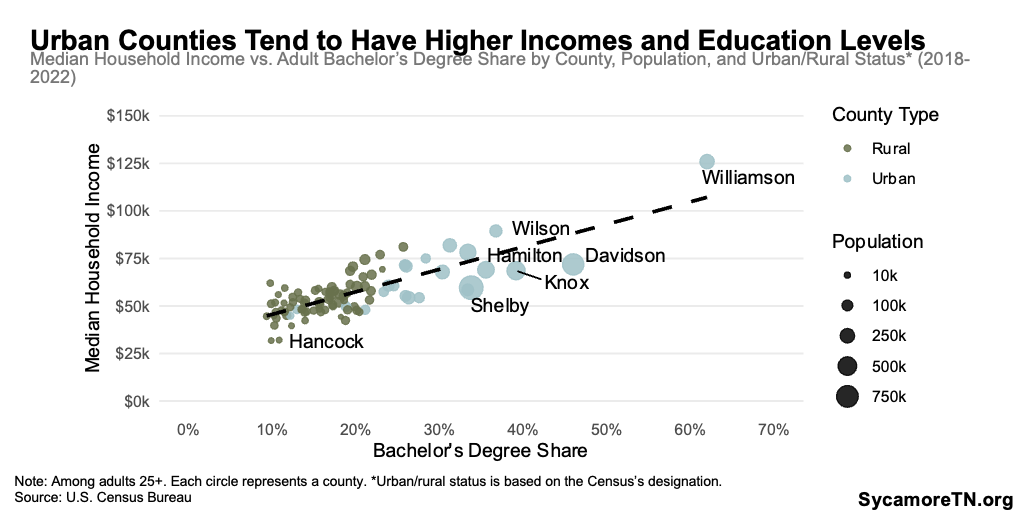
Health Insurance Coverage
In 2018-2022, Tennessee had a larger share of uninsured individuals than most of the country (Figure 20). The state’s 10.1% uninsured rate exceeded the national rate of 8.7%. It was higher than in 38 other states and D.C. The uninsured rate among those ages 19-64 was 14.6%, which drove Tennessee’s high overall uninsured rate. State uninsured rates were considerably lower among those under 19 (5.4%) and those ages 65+ (0.6%). (6)
Figure 20
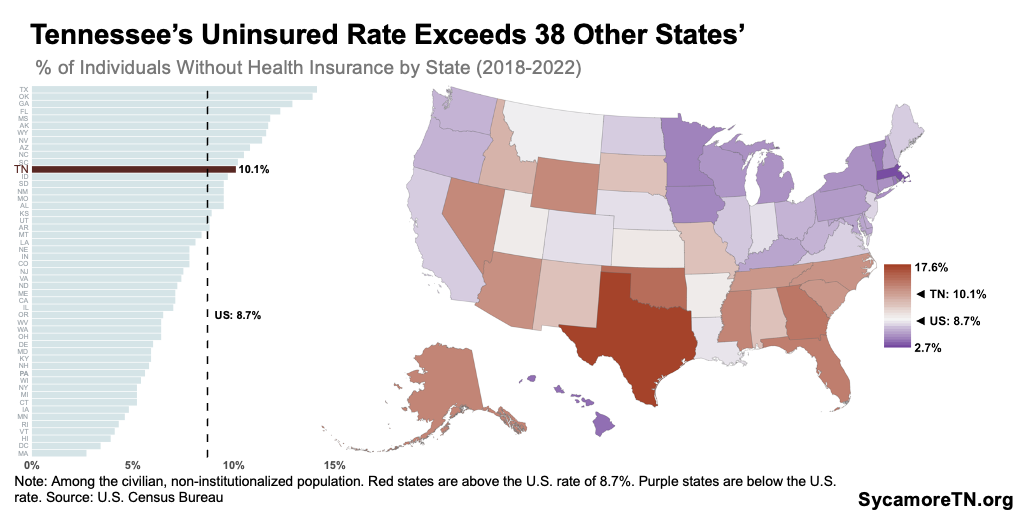
Within Tennessee, 77 counties have an uninsured rate that exceeds the national rate, and there are large gaps between the most and least insured counties (Figure 21). For example, at 4.2%, Williamson County had the lowest uninsured rate, over four times lower than Bledsoe County, the highest at 17%. (6)
Figure 21
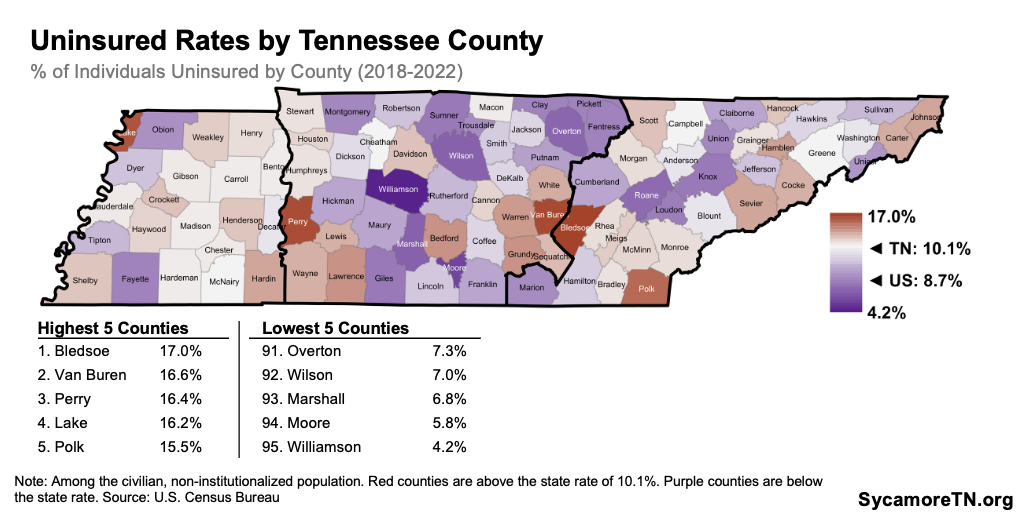
Figure 22
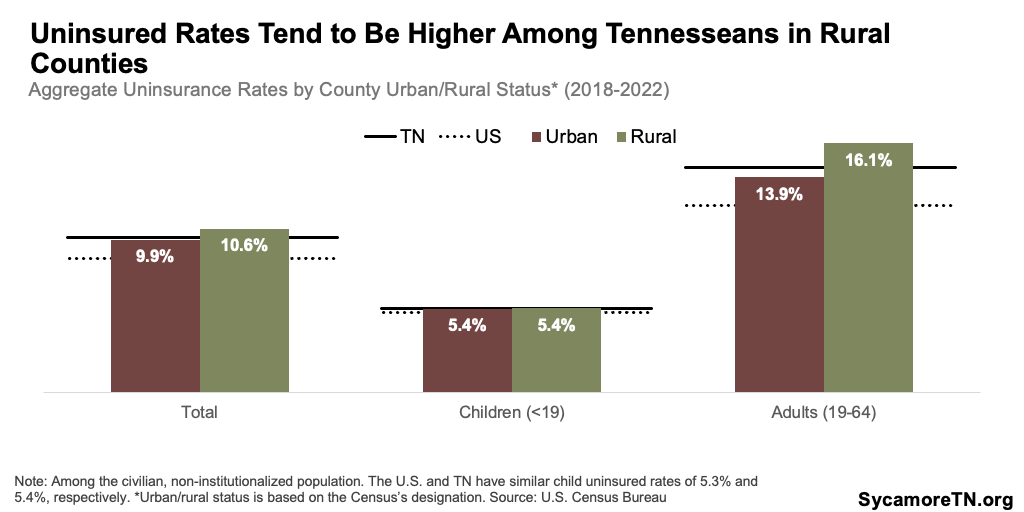
Other key findings include:
- Rural vs. Urban – The uninsured rate was higher in rural counties (10.6%) than in urban counties (9.9%) in 2018-2022 (Figures 22 and 23). (6)
- Grand Division – Across Tennessee’s three Grand Divisions, West Tennesseans’ uninsured rate was highest (Figure 24). In 2018-2022, 11.3% of West Tennesseans lacked health insurance — compared to 9.6% of Middle Tennesseans and 9.9% of East Tennesseans. (6)
- Children – The uninsured rate among youth under 19 years old ranged from 0.3% in Pickett County to 18.9% in Van Buren County (Figure 25).(6)
- Working-Age Adults — Statewide, the uninsured rate was highest among those aged 19-64 at 14.4% (Figure 26). (6) Coverage rates for adults in this age group varied widely by county. In Williamson County, the uninsured rate was 5.9%, over four times lower than in Polk (23.6%), Bledsoe (24.9%), Perry (26.2%), and Lake (26.2%) Counties. (6)
Figure 23
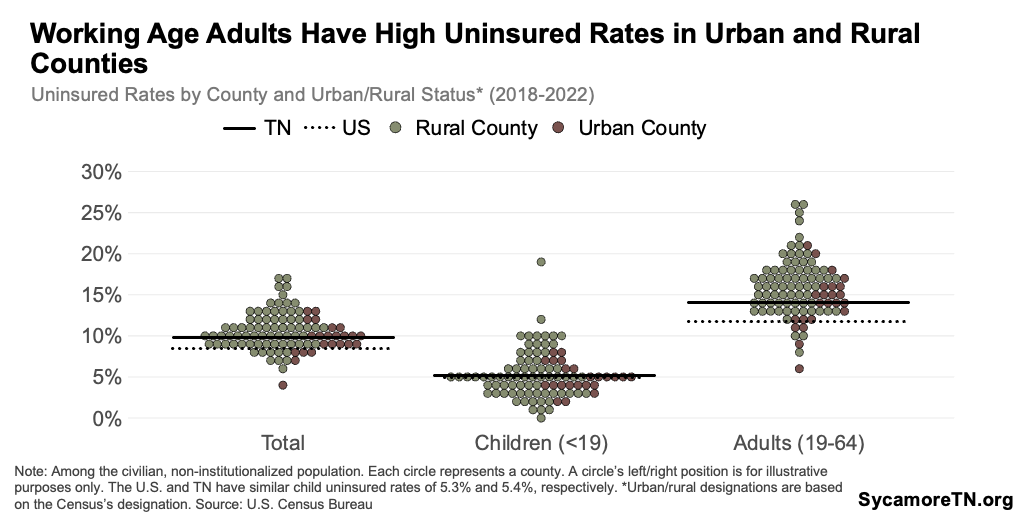
Figure 24
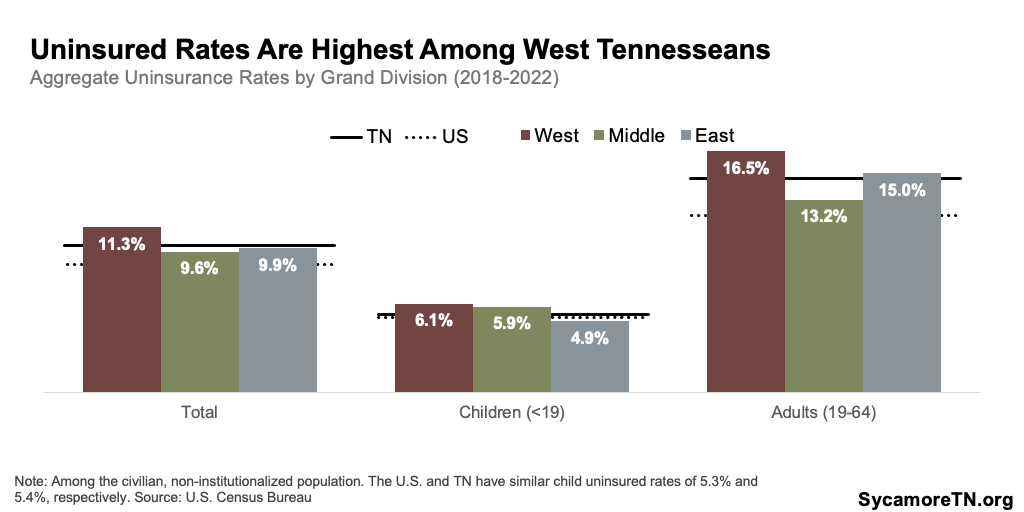
Figure 25
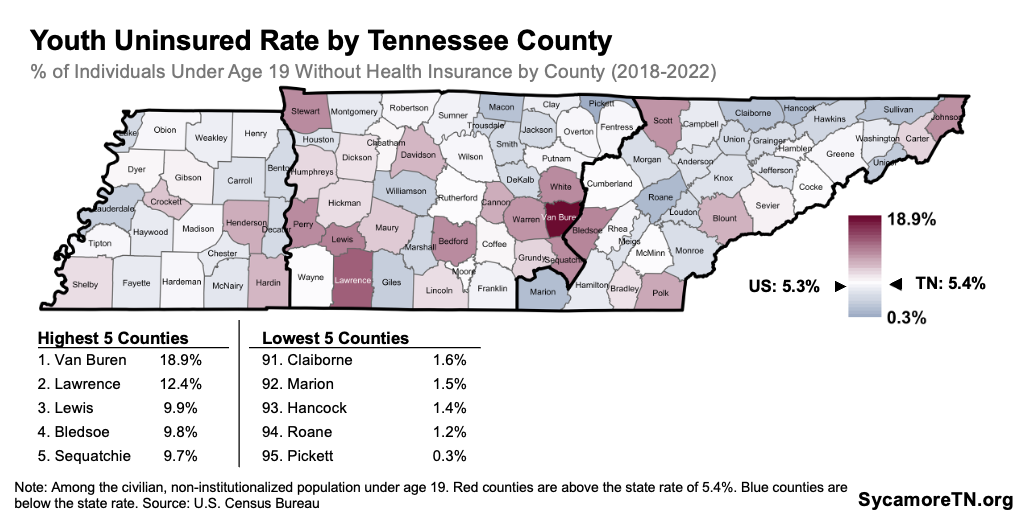
Figure 26
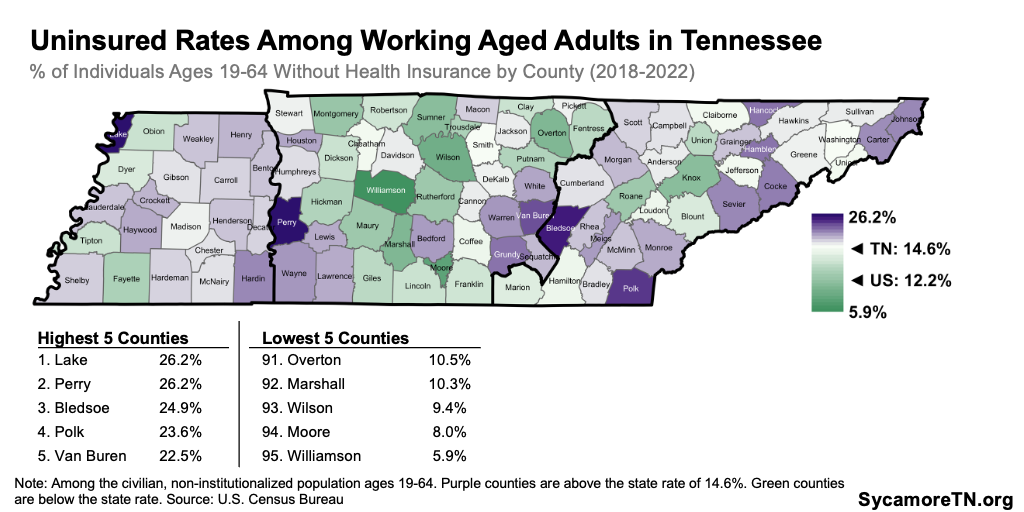
About the Data
The five-year estimates presented here are based on the U.S. Census Bureau’s American Community Survey collected from 2018-2022. They are the most current data available, as there is about a one-year lag between when data collection stops and when the Census Bureau publishes them. While many metrics are often discussed in the context of a single year, the Census Bureau does not publish one-year estimates for areas with small populations, which excludes many Tennessee counties. Instead, they pool data across several years to minimize sampling error and produce more accurate measures. These multi-year estimates are more reliable than one-year estimates for areas with smaller populations and provide comparable data for all counties in Tennessee. Even with multiple years of data, however, the estimates for less populous counties generally have wider margins of error.
*This post was updated on February 4, 2025 to update the chart in Figure 22.
References
Click to Open/Close
- Spears, Mandy. 2022 Census Data on Income & Poverty in Tennessee. Economy. [Online] The Sycamore Institute, March 7, 2022. [Cited: March 28, 2024.] https://www.sycamoretn.org/2022-census-income-poverty/.
- United States Census Bureau. Urban and Rural: County-level 2020 Census Urban and Rural Information for the U.S., Puerto Rico, and Island Areas sorted by state and county FIPS codes [10 MB]. [Online] September 2023. [Cited: February 28, 2024.] https://www.census.gov/programs-surveys/geography/guidance/geo-areas/urban-rural.html.
- U.S. Census Bureau. “Poverty Status in the Past 12 Months.” American Community Survey, ACS 5-Year Estimates Subject Tables, Table S1701. [Online] 2022. [Cited: April 17, 2024.] https://data.census.gov/table/ACSST5Y2022.S1701?q=S1701&g=040XX00US47. Some data are also available from KIDS COUNT Data Center via https://datacenter.aecf.org/.
- —. “Median Income in the Past 12 Months (in 2022 Inflation-Adjusted Dollars).” American Community Survey, ACS 5-Year Estimates Subject Tables, Table S1903. [Online] 2022. [Cited: April 17, 2024.] https://data.census.gov/table/ACSST5Y2022.S1903?q=S1903&g=040XX00US47.
- —. “Educational Attainment.” American Community Survey, ACS 5-Year Estimates Subject Tables, Table S1501. Explore Census Data. [Online] 2022. [Cited: April 19, 2024.] https://data.census.gov/table/ACSST5Y2022.S1501?g=040XX00US47.
- —. “Selected Characteristics of Health Insurance Coverage in the United States.” American Community Survey, ACS 5-Year Estimates Subject Tables, Table S2701. Explore Census Data. [Online] 2022. [Cited: April 18, 2024.] https://data.census.gov/table/ACSST5Y2022.S2701?q=S2701&g=040XX00US47.


